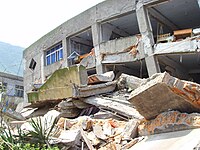
Photo from wikipedia
Abstract With Tibetan Plateau higher than 4 km to the west, the location of Sichuan Basin is unique all around the world and provides a good platform to study air pollution… Click to show full abstract
Abstract With Tibetan Plateau higher than 4 km to the west, the location of Sichuan Basin is unique all around the world and provides a good platform to study air pollution in the urban agglomerations over the complex terrain. To fill in the blanks on vertical distributions of PM1 (the particles smaller than 1 μm) and carbonaceous aerosols within the basin, by means of high topographic relief, PM1 were off-line sampled during 20 January to 2 February 2018 at eight sites with increasing altitudes from the basin to southeastern margins of the Tibetan Plateau. The regional potential sources for each site were revealed by HYbrid-Single Particle Lagrangian Integrated Trajectory (HYSPLIT) model and concentration-weighted trajectory (CWT) method. The lowest carbonaceous aerosol levels occurred at Lixian, while the highest OC (organic carbon) (EC, elemental carbon) was at Hongyuan (the altitude of 3500 m) (Ande, a rural site) due to more primary emissions. The pollutants inside the basin can be transported the altitudes from 2 km to 3 km by vertical dispersion, but they cannot be dispersed to higher altitudes. The vertical stratification of the pollutants was obvious and easily formed “high-low-high” pattern from Sichuan Basin to southeastern Tibetan Plateau, especially during highly polluted episodes. The regional potential sources significantly varied as the increased altitudes. Regional pollution was significant inside the basin. The sources at the altitudes from 2 km to 3 km originated from southeastern margins of the Plateau and surrounding cities, while those at higher altitudes were transported from southeastern margins of the Plateau. The impact of basic meteorological variables (temperature, wind speed and vapor pressure) on carbonaceous aerosols was opposite between the basin and Plateau sites. This study was essential to understanding formation mechanisms of severe pollution episodes and thus to making control measures for the urban agglomerations inside the mountainous terrain.
Journal Title: Atmospheric Environment
Year Published: 2020
Link to full text (if available)
Share on Social Media: Sign Up to like & get
recommendations!